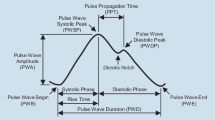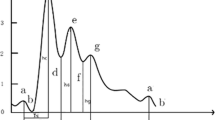Abstract
Cardiovascular disease is the main cause of death in Europe, and early detection of increased cardiovascular risk (CR) is of clinical importance. Pulse wave analysis based on pulse oximetry has proven useful for the recognition of increased CR. The current study provides a detailed description of the pulse wave analysis technology and its clinical application. A novel matching pursuit-based feature extraction algorithm was applied for signal decomposition of the overnight photoplethysmographic pulse wave signals obtained by a single-pulse oximeter sensor. The algorithm computes nine parameters (pulse index, SpO2 index, pulse wave amplitude index, respiratory-related pulse oscillations, pulse propagation time, periodic and symmetric desaturations, time under 90 % SpO2, difference between pulse and SpO2 index, and arrhythmia). The technology was applied in 631 patients referred for a sleep study with suspected sleep apnea. The technical failure rate was 1.4 %. Anthropometric data like age and BMI correlated significantly with measures of vascular stiffness and pulse rate variability (PPT and age r = −0.54, p < 0.001, PR and age r = −0.36, p < 0.01). The composite biosignal risk score showed a dose–response relationship with the number of CR factors (p < 0.001) and was further elevated in patients with sleep apnea (AHI ≥ 15n/h; p < 0.001). The developed algorithm extracts meaningful parameters indicative of cardiorespiratory and autonomic nervous system function and dysfunction in patients suspected of SDB.







Similar content being viewed by others
Abbreviations
- AHI:
-
Apnea–Hypopnea Index
- Arryth:
-
Irregular heart rate
- BMI:
-
Body mass index
- CV:
-
Cardiovascular
- CPAP:
-
Continuous positive airway pressure
- MAD:
-
Mean absolute deviation
- MP:
-
Matching pursuit
- OSA:
-
Obstructive sleep apnea
- PASD:
-
Periodic and symmetric desaturations
- PR:
-
Pulse rate
- PWA:
-
Pulse wave amplitude
- PPT:
-
Pulse propagation time
- PR_SpO2_I:
-
Difference between pulse index and SpO2 index
- RRPO:
-
Respiratory-related pulse oscillation
- SDB:
-
Sleep-disordered breathing
- SpO2 :
-
Oxygen saturation
- TimeBelow90:
-
Time under 90 % SpO2
References
Aittokallio J, Polo O, Hiissa J, Virkki A, Toikka J, Raitakari O, Saaresranta T, Aittokallio T (2008) Overnight variability in transcutaneous carbon dioxide predicts vascular impairment in women. Exp Physiol 93(7):880–891
Aittokallio J, Saaresranta T, Virkki A, Karppinen N, Heinonen OJ, Aittokallio T, Polo O (2009) Transcutaneous carbon dioxide profile during sleep reveals metabolic risk factors in postmenopausal females. Eur Respir J 34:1132–1139
Allen J (2007) Photoplethysmography and its application in clinical physiological measurement. Physiol Meas 28:R1–R39
Bergeaud F, Mallat S (1995) Matching pursuit of images. In: Proceedings of the international conference on image processing, vol 1, pp 53–56
Buchs A, Slovik Y, Rapoport M, Rosenfeld C, Khanokh B, Nitzan M (2005) Right–left correlation of the sympathetically induced fluctuations of photoplethysmographic signal in diabetic and non-diabetic subjects. Med Biol Eng Comput 43(2):252–257
Conroy RM et al (2003) Estimation of ten-year risk of fatal cardiovascular disease in Europe: the SCORE project. Eur Heart J 24:987–1003
Danesh J et al (2004) C-reactive protein and other circulating markers of inflammation in the prediction of coronary heart disease. N Engl J Med 350:1387–1397
Don DS et al (1999) Risk factors for central and obstructive sleep apnea in 450 men and women with congestive heart failure. Am J Respir Crit Care Med 160(4):1101–1106
Durka PJ, Blinowska KJ (1995) Analysis of EEG transients by means of matching pursuit. Ann Biomed Eng 23:608–611
Durka PJ, Matysiak A, Martinez ME, Valdés SP, Blinowska KJ (2005) Multichannel matching pursuit and EEG inverse solutions. J Neurosci Methods 148(1):49–59
Grote L, Sommermeyer D, Zou D, Eder DN, Hedner J (2011) Oximeter-based autonomic state indicator algorithm for cardiovascular risk assessment. Chest 139(2):253–259
Guilbert JJ (2003) The world health report 2002—reducing risks, promoting healthy life. Educ Health (Abingdon) 16(2):230
Khanoka B, Slovik Y, Landau D, Nitzan M (2004) Sympathetically induced spontaneous fluctuations of the photoplethysmographic signal. Med Biol Eng Comput 42(1):80–85
Mallat S, Zhang Z (1993) Matching Pursuit in a time-frequency dictionary. IEEE Trans Signal Process 41:3397–3415
Mannheimer PD (2007) The light-tissue interaction of pulse oximetry. Anesth Analg 105(6 Suppl):S10–S17
Mendels F et al (2006) Matching pursuit-based shape representation and recognition using scale-space. Int J Imaging Syst Technol 16(5):162–180
Millasseau SC, Ritter JM, Takazawa K, Chowienczyk PJ (2006) Contour analysis of the photoplethysmographic pulse measured at the finger. J Hypertens 24:1449–1456
Myers RH et al (1990) Parental history is an independent risk factor for coronary artery disease: the Framingham Study. Am Heart J 120:963–969
Neff R, Zakhor A (1997) A very low bit-rate video coding based on matching pursuits. IEEE Trans Circuits Syst Video Technol 7(1):158–171
Nitzan M et al (1998) The variability of the photoplethysmographic signal—a potential method for the evaluation of the autonomic nervous system. Physiol Meas 19:93–102
Pfeifer MA, Weinberg CR, Cook D, Best JD, Reenan A, Halter JB (1983) Differential changes of autonomic nervous system function with age in man. Am J Med 75:249–258
Rankine L, Mesbah M, Boashash B (2007) A matching pursuit-based signal complexity measure for the analysis of newborn EEG. Med Biol Eng Comput 45(3):251–260
Schönwald VS et al (2006) Benchmarking matching pursuit to find sleep spindles. J Neurosci Methods 156(1–2):314–321
Sommermeyer D, Zou D, Eder DN, Hedner J, Ficker JH, Randerath W, Priegnitz C, Penzel T, Fietze I, Sanner B, Grote L (2014) The use of overnight pulse wave analysis for recognition of cardiovascular risk factors and risk: a multicentric evaluation. J Hypertens 32(2):276–285. doi:10.1097/HJH.0000000000000039
Wang W, Guo Z, Yang J, Zhang Y, Durand LG, Loew M (2001) Analysis of the first heart sound using the matching pursuit method. Med Biol Eng Comput 39(6):644–648
Wang XH, Hong JR (1998) On the handling of fuzziness for continuous-valued attributes in decision tree generation. Fuzzy Sets Syst 99:283–290
Weber T et al (2004) Arterial stiffness, wave reflections, and the risk of coronary artery disease. Circulation 109:184–189
European Society of Hypertension-European Society of Cardiology Guidelines Committee (2003) 2003 European Society of Hypertension–European Society of Cardiology guidelines for the management of arterial hypertension. J Hypertens 21(6):1011–1053
Acknowledgments
Funding
The study was supported by Weinmann Geräte für Medizin GmbH & Co.KG, MCC GmbH & Co.KG, the German Ministry for Education and Science (BMBF), the Swedish Heart and Lung Foundation, the Gothenburg Medical Society and the Sahlgrenska Academy at the University of Gothenburg, Sweden.
Other contributions
The authors would like to express their gratitude for the support throughout the study to Jeanette Norum (Sahlgrenska), Lena Engelmark (Sahlgrenska), Martina Bögel (Weinmann, Hamburg, Germany), Matthias Schwaibold (MCC, Karlsruhe, Germany), and Bernd Schöller (MCC, Karlsruhe, Germany) for their technical and intellectual input during different parts of the study.
Author information
Authors and Affiliations
Corresponding author
Rights and permissions
About this article
Cite this article
Sommermeyer, D., Zou, D., Ficker, J.H. et al. Detection of cardiovascular risk from a photoplethysmographic signal using a matching pursuit algorithm. Med Biol Eng Comput 54, 1111–1121 (2016). https://doi.org/10.1007/s11517-015-1410-8
Received:
Accepted:
Published:
Issue Date:
DOI: https://doi.org/10.1007/s11517-015-1410-8




